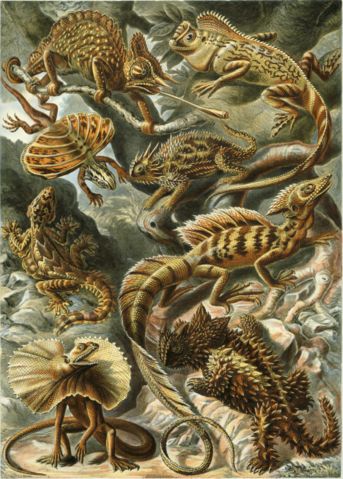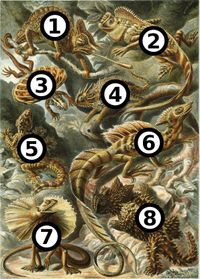From Wikipedia, the free encyclopedia
 Size of this preview: 343 × 479 pixels
Size of this preview: 343 × 479 pixels Full resolution (2,378 × 3,320 pixels, file size: 2.12 MB, MIME type: image/jpeg)
 |
This is a file from the Wikimedia Commons. The description on its description page there is shown below.Commons is a freely licensed media file repository. You can help.
|
Summary
The 79th lithographic plate from Ernst Haeckel's Kunstformen der Natur (1904) depicts a variety of lizards, or Lacertilia. In terms of evolutionary relationships, these eight lizards demonstrate the diversity of the Lacertilia suborder, which has been replaced by an array of new suborders and infraorders in recent classifications. Unusual species of chameleon and gonocephalus are at the top; the second row has a flying dragon and a Texas horned lizard; the third row has a flying gecko and a common basilisk; on the bottom row are the aptly named frill-necked lizard and the Thorny Devil. As in many of Haeckel's prints, the colors and spatial composition are more of an aesthetic choice than a reproduction of nature; the lithographer Adolf Glitsch worked directly from Haeckel's sketches rather than from first-hand specimens.
Species
- Chamaeleon montium (now: Chamaeleo montium)
- Lophyrus tigrinus (now: Gonocephalus chamaeleontinus)
- Draconellus volans (now Draco volans)
- Phrynosoma cornutum
- Ptychozoon homalocephalum (aka Flying gecko)
- Basiliscus americanus (aka Basiliscus basiliscus)
- Chlamydosaurus kingii
- Moloch horridus
Reference
Olaf Breidbach, Visions of Nature: The Art and Science of Ernst Haeckel. Prestel Verlag: New York, 2006.
Related images
Descriptive text (in German)
|
|
Licensing
|
|
This image (or other media file) is in the public domain because its copyright has expired.
This applies to the United States, Canada, the European Union and those countries with a copyright term of life of the author plus 70 years.
 Note that a few countries have copyright terms longer than 70 years: Mexico has 100 years, Colombia has 80 years, and Guatemala and Samoa have 75 years. This image may not be in the public domain in these countries, which moreover do not implement the rule of the shorter term. Côte d'Ivoire has a general copyright term of 99 years and Honduras has 75 years, but they do implement that rule of the shorter term. Note that a few countries have copyright terms longer than 70 years: Mexico has 100 years, Colombia has 80 years, and Guatemala and Samoa have 75 years. This image may not be in the public domain in these countries, which moreover do not implement the rule of the shorter term. Côte d'Ivoire has a general copyright term of 99 years and Honduras has 75 years, but they do implement that rule of the shorter term.
العربية | Asturianu | Български | Català | Česky | Dansk | Deutsch | English | Ελληνικά | Esperanto | Español | Euskara | فارسی | Français | Gaeilge | Galego | עברית | हिन्दी | Bahasa Indonesia | Italiano | 日本語 | 한국어 | Kurdî / كوردی | Lietuvių | Magyar | Nederlands | Norsk (nynorsk) | Македонски | Bahasa Melayu | Polski | Português | Română | Русский | Slovenčina | Slovenščina | Shqip | Suomi | Sámegiella | Türkçe | 中文(简体) | 中文(繁體) | 粵語 | +/- |
File history
Click on a date/time to view the file as it appeared at that time.
|
|
Date/Time |
Dimensions |
User |
Comment |
| current |
02:01, 1 March 2006 |
2,378×3,320 (2.12 MB) |
Ragesoss |
|
|
|
22:08, 26 February 2006 |
2,378×3,321 (2.16 MB) |
Ragesoss |
|
File links
The following pages on Schools Wikipedia link to this image (list may be incomplete):




